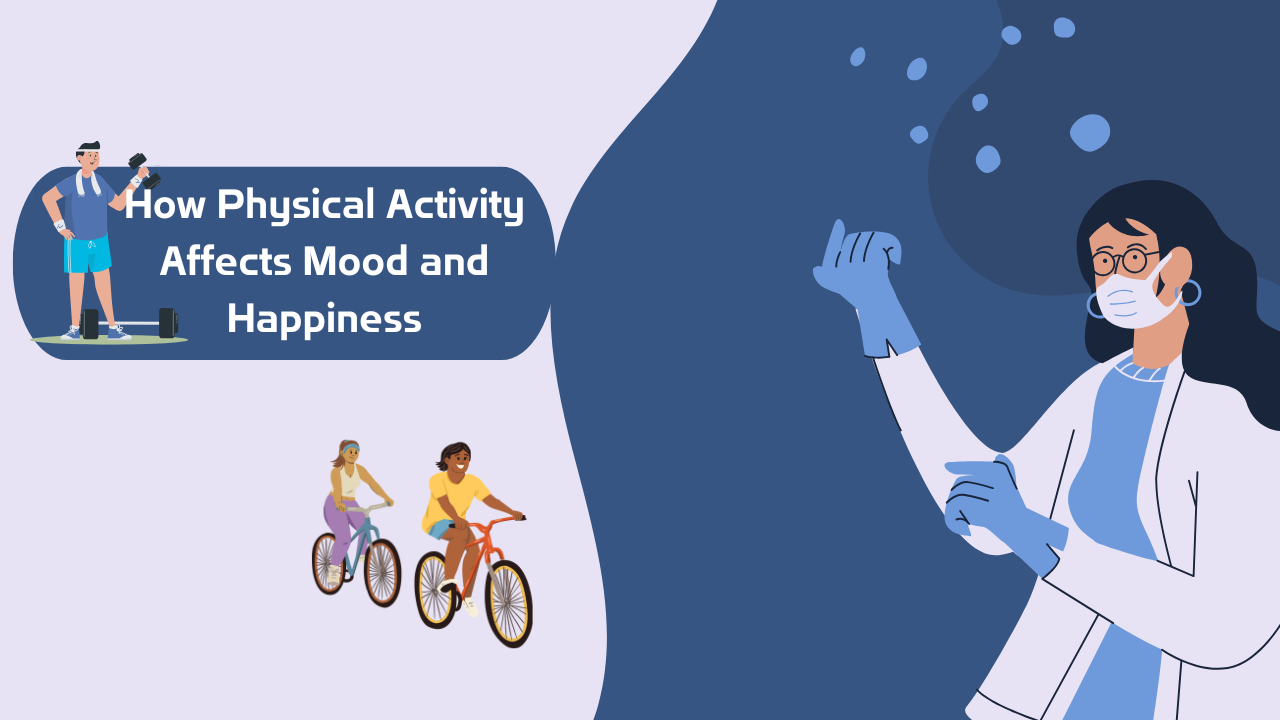Introduction
Do you ever feel an energy boost and uplift after a good exercise session? Or realize that a short walk can clear your thoughts after a long day? It’s no accident—exercise has a powerful effect on our moods, mental health, and overall happiness.
In the modern world, stress, anxiety, and depression are on the rise. Most individuals seek medication or therapy to treat their mental well-being, but a very effective and often neglected solution is exercise regularly. Whether jogging, yoga, weight training, or merely a walk in the park, exercise has the ability to boost our mood and make us happier.
But how does exercise improve mental health? What biological and psychological mechanisms are at play? And what types of exercises are most effective? In this article, we’ll explore the science behind physical activity and its impact on mood, provide real-life examples, and offer practical tips to incorporate movement into your daily routine.
The Science Behind Exercise and Happiness
How Exercise Affects the Brain

When we are physically active, our brain also experiences a few chemical and structural alterations that immediately affect our feelings. Some of the major processes involved are as follows:
- Release of Endorphins:
Exercise releases endorphins, also known as the “feel-good hormones.” These are natural painkillers that act on receptors in the brain to decrease the perception of pain and produce a feeling of euphoria. That is why runners usually get a “runner’s high” after a long-distance run. - Increase in Dopamine and Serotonin Levels:
- Dopamine is the reward chemical of the brain. It makes us more motivated, pleased, and satisfied. Exercise boosts the production of dopamine, which causes better concentration, mood, and even recovery from addiction.
- Serotonin is a neurotransmitter that regulates mood. Depression and anxiety are linked with low serotonin, but elevated serotonin due to exercise enhances feelings of happiness and calmness.
- Decrease in Cortisol and Stress Hormones:
Stress is one of the major causes of mood disorders. Exercise lowers cortisol levels, which, when high, lead to anxiety, fatigue, and irritability. Through physical activity, we directly fight stress and bring about a sense of relaxation. - Neurogenesis (Development of New Brain Cells):
Studies have established that exercise stimulates neurogenesis, the creation of new neurons in the hippocampus, the region of the brain that is involved in memory and emotional control. This is essential in avoiding cognitive impairment and mental illness.
Exercise as a Natural Antidepressant

An increasing amount of evidence indicates that exercise may be as effective as antidepressant medication in the treatment of mild to moderate depression.
- A Journal of Psychiatric Research study discovered that those who exercised for 30 minutes, 3-5 times a week, showed significant decreases in depressive symptoms.
- Another study by Harvard Medical School discovered that jogging for 15 minutes daily or walking for an hour decreases the risk of severe depression by 26%.
How is this possible? In contrast to drugs, which artificially elevate levels of neurotransmitters, exercise naturally adjusts and balances brain chemicals, creating long-term benefits to mental well-being without side effects.
Types of Physical Activity That Boost Mood and Happiness
Not all forms of exercise have the same effect on mood. Certain types of exercise are especially good at improving emotional health.
1. Aerobic Exercise (Cardio Workouts)
Cardio exercises like running, swimming, cycling, and brisk walking enhance oxygen supply to the brain and trigger the release of mood-boosting neurotransmitters. Research indicates that even 20-30 minutes of daily aerobic exercise can dramatically lower stress levels and improve mood.
2. Strength Training (Weightlifting & Bodyweight Exercises)
Strength training like weightlifting, push-ups, or squats, not only aids in the growth of muscles but also in increasing self-esteem and resistance to stress. Studies have revealed that participants involved in strength training two times a week have fewer occurrences of anxiety and depression.
3. Yoga and Mindfulness-Based Exercises
Yoga incorporates physical movement, deep breathing, and meditation, which is why it is one of the best exercises to reduce stress. A 2019 study published in the Journal of Psychiatric Practice concluded that participants who practiced yoga for eight weeks showed substantial decreases in anxiety and mood swings.
4. Outdoor Activities (Hiking, Walking in Nature, Gardening)
Nature has its own set of mental well-being benefits. Hiking, cycling in a park, or even maintaining a garden exposes us to natural sunlight, which helps increase levels of vitamin D and improves mood. Research shows that being in nature for just 20 minutes can drastically reduce cortisol levels.
5. Group Activities and Team Sports
Engaging in group activities, like dance classes, soccer, or CrossFit, improves social bonding and emotional support. Exercising with others results in the release of oxytocin, a hormone that creates feelings of happiness and bonding.
Real-Life Stories: How Exercise Transformed Lives
Case Study 1: Overcoming Anxiety with Running
Sarah, aged 35, was a teacher who had struggled with anxiety for years. Her anxiety was manageable with traditional therapy, but the stress was overwhelming at times. One morning, she began to jog. It took a few weeks, but she felt much better about her mood, sleeping, and well-being. Now, running is her go-to way of keeping anxiety at bay.
Case Study 2: Strength Training for Confidence
Mark, who is 40 years old and an accountant, had low self-esteem and was bored with a sedentary life. After adding weightlifting to his lifestyle, he not only noticed physical changes but also mental toughness and confidence that carried over to his personal and work life.
Actionable Tips to Add Exercise to Your Everyday Routine
- Begin Small: Start with only 10 minutes of activity a day and build up the intensity.
- Select an Exercise You Love: Dancing, swimming, or hiking – whatever gets your heart rate up and you moving – do it.
- Schedule Workout Sessions Like You Would an Appointment: Stick with it. Set a reminder on your phone to remind you to continue.
- Whenever Possible, Exercise Outdoors: Sunlight and fresh air have added mood-boosting advantages.
- Listen to Music or Podcasts: Positive music increases motivation and enjoyment of workouts.
- Combine Exercise with Social Interaction: Play on a sports team, take a yoga class, or work out with friends to remain motivated.
- Pay Attention to Mindfulness During Workouts: Notice your breathing, posture, and the sensations in your body to promote relaxation.
The Long-Term Benefits of an Active Lifestyle
In addition to the immediate improvement in mood, frequent exercise has long-term mental and emotional advantages, such as:
- Lower risk of depression and anxiety
- Better sleep quality and more energy
- Better cognitive function and memory
- Improved emotional resilience and stress management
- Higher self-esteem and confidence
Conclusion
Physical activity is the most effective, natural means to enhance mental happiness and well-being. Through movement on a daily basis—be it a daily walk, yoga practice, or intense exercise—you can elevate mood, lower stress, and heighten overall health.
So, what are you waiting for? Even a few minutes of movement a day can have an impact. Take that first step today—your mind and body will thank you for it!
Meta Description:
Learn how exercise enhances mood and happiness through brain chemistry, stress relief, and mindful movement. Get actionable advice for a healthier, happier life.
Suggested Royalty-Free Images:
- Smiling person running in the park
- A session of outdoor friends’ yoga
- Infographic entitled “The Science of Exercise and Happiness”
Can I include further studies or professional references, though? ????
Readmore…https://totalinsights.online/wp-admin/post.php?post=29083&action=edit

